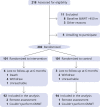Lifestyle Walking Intervention for Patients With Heart Failure With Reduced Ejection Fraction: The WATCHFUL Trial
- PMID: 37955615
- PMCID: PMC10782943
- DOI: 10.1161/CIRCULATIONAHA.123.067395
Lifestyle Walking Intervention for Patients With Heart Failure With Reduced Ejection Fraction: The WATCHFUL Trial
Abstract
Background: Physical activity is pivotal in managing heart failure with reduced ejection fraction, and walking integrated into daily life is an especially suitable form of physical activity. This study aimed to determine whether a 6-month lifestyle walking intervention combining self-monitoring and regular telephone counseling improves functional capacity assessed by the 6-minute walk test (6MWT) in patients with stable heart failure with reduced ejection fraction compared with usual care.
Methods: The WATCHFUL trial (Pedometer-Based Walking Intervention in Patients With Chronic Heart Failure With Reduced Ejection Fraction) was a 6-month multicenter, parallel-group randomized controlled trial recruiting patients with heart failure with reduced ejection fraction from 6 cardiovascular centers in the Czech Republic. Eligible participants were ≥18 years of age, had left ventricular ejection fraction <40%, and had New York Heart Association class II or III symptoms on guidelines-recommended medication. Individuals exceeding 450 meters on the baseline 6MWT were excluded. Patients in the intervention group were equipped with a Garmin vívofit activity tracker and received monthly telephone counseling from research nurses who encouraged them to use behavior change techniques such as self-monitoring, goal-setting, and action planning to increase their daily step count. The patients in the control group continued usual care. The primary outcome was the between-group difference in the distance walked during the 6MWT at 6 months. Secondary outcomes included daily step count and minutes of moderate to vigorous physical activity as measured by the hip-worn Actigraph wGT3X-BT accelerometer, NT-proBNP (N-terminal pro-B-type natriuretic peptide) and high-sensitivity C-reactive protein biomarkers, ejection fraction, anthropometric measures, depression score, self-efficacy, quality of life, and survival risk score. The primary analysis was conducted by intention to treat.
Results: Of 218 screened patients, 202 were randomized (mean age, 65 years; 22.8% female; 90.6% New York Heart Association class II; median left ventricular ejection fraction, 32.5%; median 6MWT, 385 meters; average 5071 steps/day; average 10.9 minutes of moderate to vigorous physical activity per day). At 6 months, no between-group differences were detected in the 6MWT (mean 7.4 meters [95% CI, -8.0 to 22.7]; P=0.345, n=186). The intervention group increased their average daily step count by 1420 (95% CI, 749 to 2091) and daily minutes of moderate to vigorous physical activity by 8.2 (95% CI, 3.0 to 13.3) over the control group. No between-group differences were detected for any other secondary outcomes.
Conclusions: Whereas the lifestyle intervention in patients with heart failure with reduced ejection fraction improved daily steps by about 25%, it failed to demonstrate a corresponding improvement in functional capacity. Further research is needed to understand the lack of association between increased physical activity and functional outcomes.
Registration: URL: https://www.clinicaltrials.gov; Unique identifier: NCT03041610.
Keywords: behavior; cardiac rehabilitation; counseling; exercise; fitness trackers; walk test; walking.
Conflict of interest statement
Figures
Comment in
-
Physical Activity for Patients With Heart Failure With Reduced Ejection Fraction: Pump up the Volume.Circulation. 2024 Jan 16;149(3):189-191. doi: 10.1161/CIRCULATIONAHA.123.067588. Epub 2023 Nov 13. Circulation. 2024. PMID: 37955620 No abstract available.
References
-
- Becher PM, Lund LH, Coats AJS, Savarese G. An update on global epidemiology in heart failure. Eur Heart J. 2022;43:3005–3007. doi: 10.1093/eurheartj/ehac248 - PubMed
-
- Heidenreich PA, Bozkurt B, Aguilar D, Allen LA, Byun JJ, Colvin MM, Deswal A, Drazner MH, Dunlay SM, Evers LR, et al. . 2022 AHA/ACC/HFSA guideline for the management of heart failure: a report of the American College of Cardiology/American Heart Association joint committee on clinical practice guidelines. Circulation. 2022;145:e895–e1032. doi: 10.1161/CIR.0000000000001063 - PubMed
-
- McDonagh TA, Metra M, Adamo M, Gardner RS, Baumbach A, Böhm M, Burri H, Butler J, Čelutkienė J, Chioncel O, et al. ; ESC Scientific Document Group. 2021 ESC guidelines for the diagnosis and treatment of acute and chronic heart failure. Eur J Heart Fail. 2022;24:4–131. doi: 10.1002/ejhf.2333 - PubMed
Publication types
MeSH terms
Associated data
LinkOut - more resources
Full Text Sources
Medical
Research Materials



